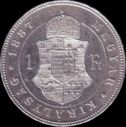Austrian florin
| Austro-Hungarian gulden | |||||
|---|---|---|---|---|---|
| Gulden (German) forint (Hungarian) florin (Latin) |
|||||
|
|||||
| Denominations | |||||
| Subunit | |||||
| 1⁄60 (to 1857) 1⁄100 (after) |
Kreuzer (German) krajczár (Hungarian) |
||||
| Symbol | F, Frt, Ft (Hungarian); Fl (Latin) | ||||
| Banknotes | 1, 5, 10, 50, 100, 1,000 Gulden / forint | ||||
| Coins |
5⁄10, 1, 4, 5, 10, 20 Kreuzer / krajczár 1⁄4, 1, 2, 4, 8 Gulden / forint 1, 2 Vereinsthaler ( 1 1⁄2, 3 Gulden / forint) |
||||
| Demographics | |||||
| User(s) | Austria-Hungary, Principality of Montenegro | ||||
| Issuance | |||||
| Central bank | Austro-Hungarian Bank | ||||
|
This infobox shows the latest status before this currency was rendered obsolete.
|
|||||
The Gulden or forint (German: Österreichisch-ungarische Gulden, Hungarian: osztrák-magyar forint, Croatian: austro-ugarska forinta/florin, Czech: rakousko-uherský zlatý) was the currency of the lands of the House of Habsburg between 1754 and 1892 (known as the Austrian Empire from 1804 to 1867 and the Austro-Hungarian Monarchy after 1867), when it was replaced by the Krone/korona as part of the introduction of the gold standard. In Austria, the Gulden was initially divided into 60 Kreuzer, and in Hungary, the forint was divided into 60 krajczár. The currency was decimalized in 1857, using the same names for the unit and subunit.
The name Gulden was used on the pre-1867 Austrian banknotes and on the German language side of the post-1867 banknotes. In southern Germany, the word Gulden was the standard word for a major currency unit. The name Florin was used on Austrian coins and forint was used on the Hungarian language side of the post-1867 banknotes and on Hungarian coins. It comes from the city of Florence, Italy where the first florins were minted.
Until 1806, Austria was the leading state of the Holy Roman Empire. With the introduction of the Conventionsthaler as the principal currency of the Empire in 1754, when it began to replace the Reichsthaler, the Gulden was defined as half of a Conventionsthaler, equivalent to 1⁄20 of a Cologne mark of silver, and was subdivided into 60 Kreuzer. Following the winding up of the Holy Roman Empire in 1806, the Gulden became the standard unit of account in the Habsburg Empire and remained so until 1892.
...
Wikipedia


